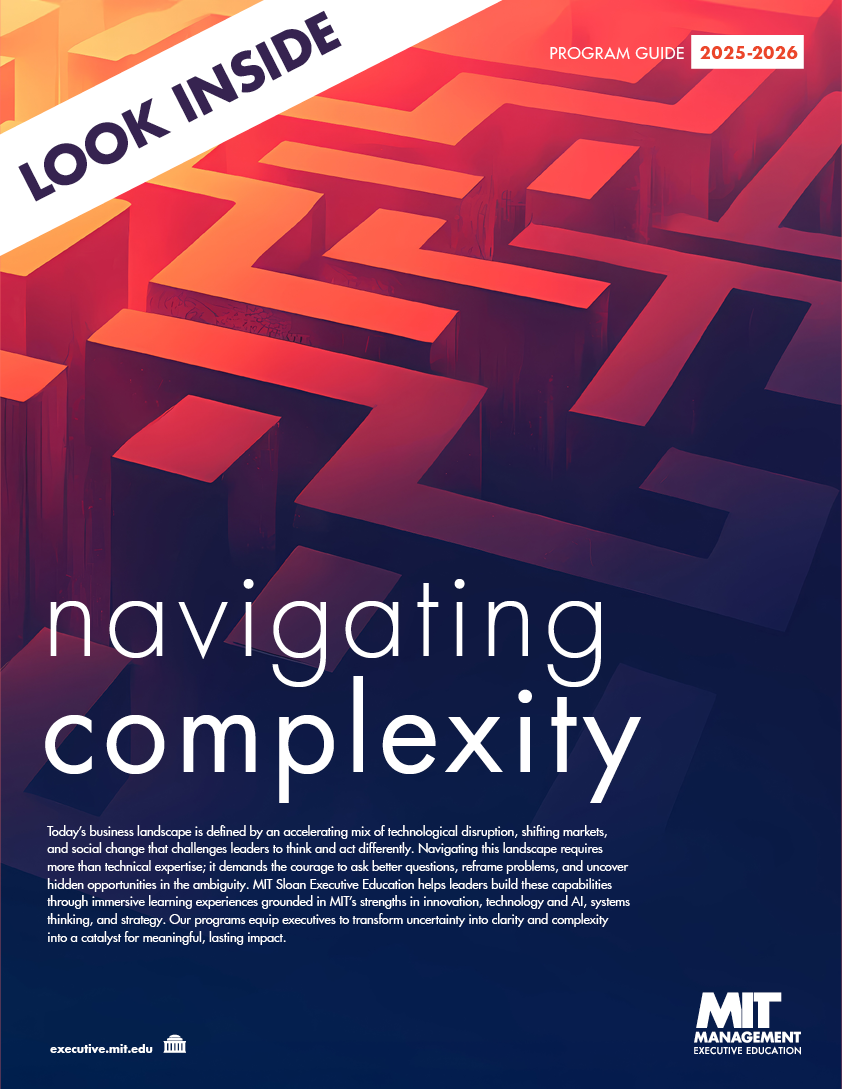“Bust the bureaucracy” is a sentiment that universally transcends government and corporate cultures. Bureaucracy has been painted as a villain that inhibits initiative, risk taking, and innovation. But what does it mean to reduce or even eliminate bureaucracy altogether? And what might the implications be for one of the most visible bureaucratic organizations—the Department of Defense (DOD)?
These are the questions Jennifer Edgin, Assistant Deputy Commandant for Information at the United States Marine Corps, asked herself as she sought to implement dynamic change in an organization residing within the walls of the Pentagon. She wondered, is bureaucracy really so bad? Or just misunderstood?
By definition, bureaucracy is “a government characterized by specialization of functions, adherence to fixed rules, and a hierarchy of authority.” This seems like a realistic characterization of any government agency, particularly a military one. But to Edgin, the ensuing framing is problematic.
“A sentiment of ‘that’s the bureaucracy and therefore we can’t change it or improve it,’ is an impediment to any kind of improvement effort,” Edgin explains. “This binary framing of bureaucracy as ‘bad’ and any other kind of work method as ‘good’ is a powerful, negative reinforcing cycle. It’s an obstacle for any leader’s strategic intent to transform an organization.”
Instead of “busting the bureaucracy” and assuming an all or nothing approach, Edgin suggests a renovation of an organization’s basic work design as a way to leverage bureaucracy where it is needed and provides value.
Information is the newest war fighting function
Upon selection to her position in the United States Marine Corps, Edgin began enrolling in courses at MIT Sloan Executive Education. “When I assumed the role, I thought it would be a good time to refresh skills, particularly as we prepared to launch a new series of initiatives aligned with the strategic goals of a new Deputy Commandant for Information.”
To understand Edgin’s role, it’s important to have some context around this relatively new war fighting function. Just as Russia and China have restructured their military forces around the concept of information, so too has the United States. In 2017, Information was established as a Joint Function with the Department of Defense (DoD). In concert, the Marine Corps reorganized its leadership and forces, establishing a new Deputy Commandant for Information (DC I). The Corps’ newest Deputy Commandant oversees all aspects of Information as the Marine Corps’ seventh warfighting function and the execution of Operations in the Information Environment (OIE). More specifically, the Marine Corps continues to adapt to compete daily in the information environment (IE), a new medium to maneuver against adversaries. Through the synchronization of cyber, space, electronic warfare, and cognitive capabilities, OIE enables combat power via information.
First to serve in her current role, Edgin is second in charge within the department of more than 1,000 Marines, sailors, and civilians (including a distributed workforce). Edgin’s role is paramount to the development and execution of plans, policies, and strategy for OIE executed by the Marine Corps, a force consisting of more than 200,000 active duty and reserve Marines. Previously, Edgin served as the Chief Technology Officer and War Room Director within DC I.
“The organization was stood up to set policies, standards, and leadership strategies that treat information as a critical war fighting function for the Marine Corps,” says Edgin. “This journey required us to maintain some critical elements of the legacy organization and build out new organizational structure and methods.”
Edgin’s department is rooted in best practices, organizational theory, and management, which is well suited for her industrial engineering, IT, and Lean Six Sigma background and expertise. Combined with her learnings from MIT, she feels she has the right toolbox to draw from as she continues to help her department tackle the quintessential transformation problem: where do you elevate what is working well, and where are new policies or processes needed?
Implementing Dynamic Work Design at the Marine Corps
Edgin earned her Advanced Certificate for Executives (ACE) from MIT Sloan Executive Education in March of this year, completing more than 25 Executive Education Units (EEUs) to meet the requirements. Among the many courses she completed as part of her ACE, takeaways from Strategies for a Sustainable Business, Visual Management for Competitive Advantage, and Leadership by Design: Innovation Process and Culture were particularly applicable to the challenge laid out above.
“As we looked at our work management system, we were able to draw on the results of ample user-driven discovery, all of which led to some interesting conversations about how we frame bureaucracy and how it is different than hierarchy,” says Edgin. “Hierarchy in the military is good—particularly on the battlefield. So, the question became, ‘how do we apply specificity to our work management system in such a way that allows us to leverage the goodness in a hierarchy while also enabling the innovation and operational flexibility required to build out the new organization of DC I to enable operations in the information environment?’”
Visual Management for Competitive Advantage centers around Dynamic Work Design, which is well suited for knowledge work environments and the elements of which proved increasingly helpful to Edgin’s team.
“We started along the journey of looking at what’s working, what’s not, and where we need new systems to emerge in order to support the Marine Corps in the information environment (IE). It was clear we had to find ways to make the work more visible especially with a distributed workforce. Dynamic Work Design offered tools and tactics that we started to implement in our organization around the principle of visualizing knowledge work in a distributed work environment.”
Edgin credits her courses for a deeper understanding of System Dynamics, an approach developed here at MIT that models the relationships between all the parts of a system and how those relationships influence the behavior of the system over time.
“System Dynamics provided a cross-functional perspective that is particularly useful to this distributed work environment as we build bridges across many sub organizations. All of this started to take shape in our campaign plan, which outlines our strategic goals and objectives and how we are implementing them. And by making this work visual, we can monitor progress against our goals and adapt as technology changes, policies change, and as the threat picture changes.”
Edgin has applied takeaways alongside other key principles from the courses she completed, including user-centered design, an iterative process in which designers focus on the users and their needs in each phase of the design process, and the concept of “design over time.”
“We have been strategic about engaging users across the Marine Corps, ranging from people in direct war fighting roles to individuals in supporting establishment roles. We’re continually working to understand their problems and use the co-creative process to articulate process improvements. And we’re designing work with a long view—bringing in a diverse thought process up front, creating a work system that allows a work system to last, and enabling innovative activities to become episodic events.”
So how does all this impact Edgin and her team’s approach to bureaucracy?
All of these tenants and principles came together in the implementation of the Campaign Plan. Lifting a page from traditional military planning, Edgin’s organization outlined three lines of efforts with specific objectives that outline the future of OIE. Then Edgin and her team overlaid the principles of visual work design to create a sight picture of objective implementation through metrics and visual work management boards. Using this visual and data driven approach, the team was then able to change how they were operating and engaging through traditional meeting events. Meetings were transformed from one-way leadership briefings to problem solving and integration sessions. The visual system empowers leaders and attendees to have targeted, results-oriented discussions resulting in more satisfying engagements and better outcomes overall for the organization.
“When we encounter the negative feedback points of a bureaucracy, if we start to unpack the statement, it’s really about understanding the entire workflow. Issues often have to do with understanding context. For example, is this problematic task step one of two or of 50? If you can deconstruct and demystify a process, people will see the entire process isn’t so bad. It’s also important to understand and communicate the value a process provides and fix the specific things that are not working. For example, if you have a process that is ‘bureaucratic’ around food safety, or safety in a training environment, the value is clear. Now you have to bring that same type of mindset to knowledge work and ensure the requester of the service and the provider of the service are aligned around expectations and metrics. This is how you dissolve the binary view of bureaucracy.”
Of course, changing the DNA of a bureaucracy doesn’t happen overnight. Edgin and her leadership team have been careful to think of the process as a journey and not a destination, to prioritize their strategies, and to work within a culture that reflects the nature of the work.
“We’ve gone on a journey within the Deputy Commandant for Information to really understand our users externally and internally, renovate existing processes, build new processes that meet our users’ needs, and align solutions that fit their problems.
We’re thrilled that these frameworks have made their way to the highest ranks of the Department of Defense. And we’re also grateful to Jennifer Edgin for a fresh perspective on what bureaucracy can offer.
The views presented by Ms. Jennifer Edgin, USMC, are hers alone and do not necessarily represent the official views of Department of Defense (DOD) or any of its components. Further, neither Ms. Jennifer Edgin, the Department of Defense (DOD), nor any of its components expressly or impliedly endorse MIT.








